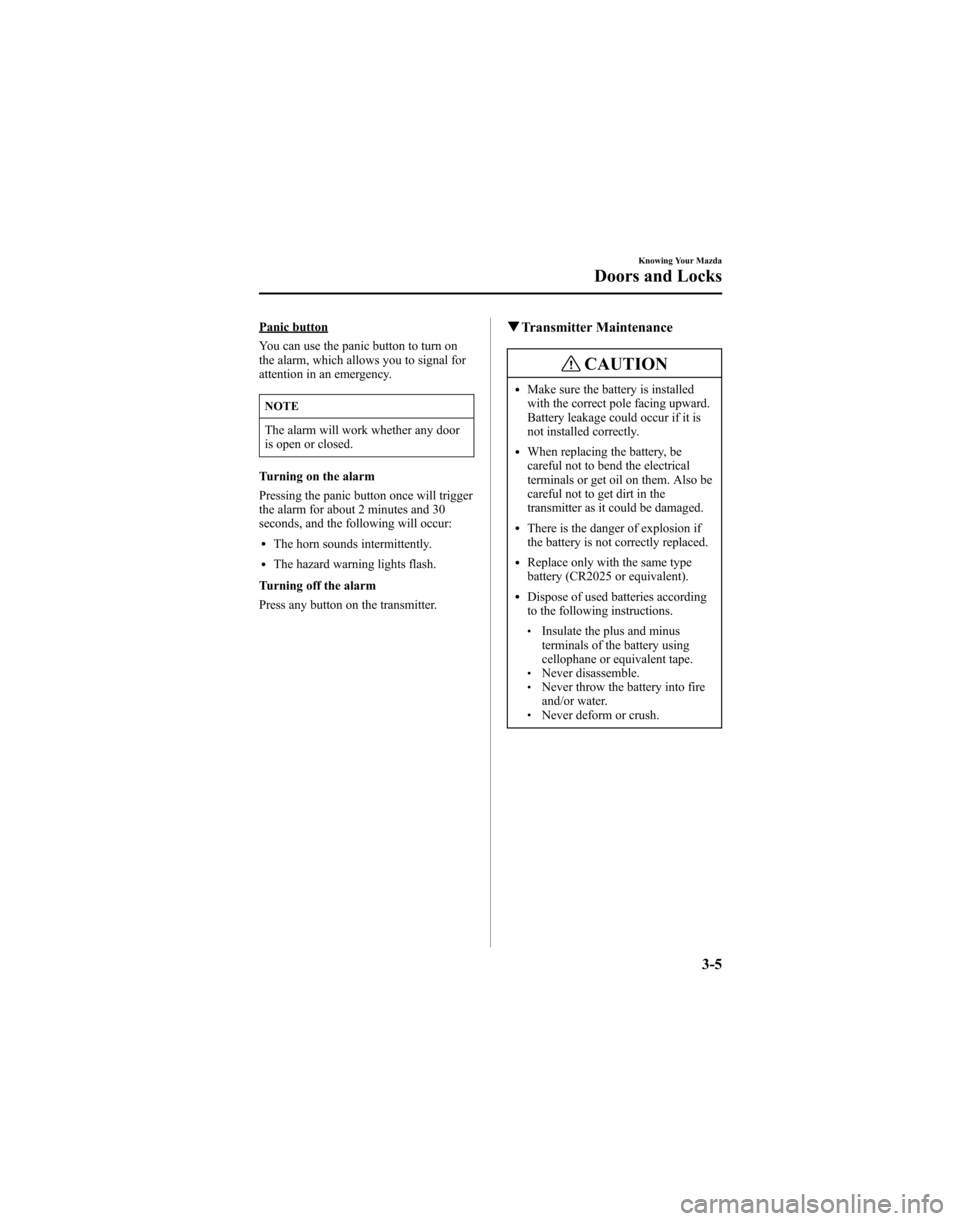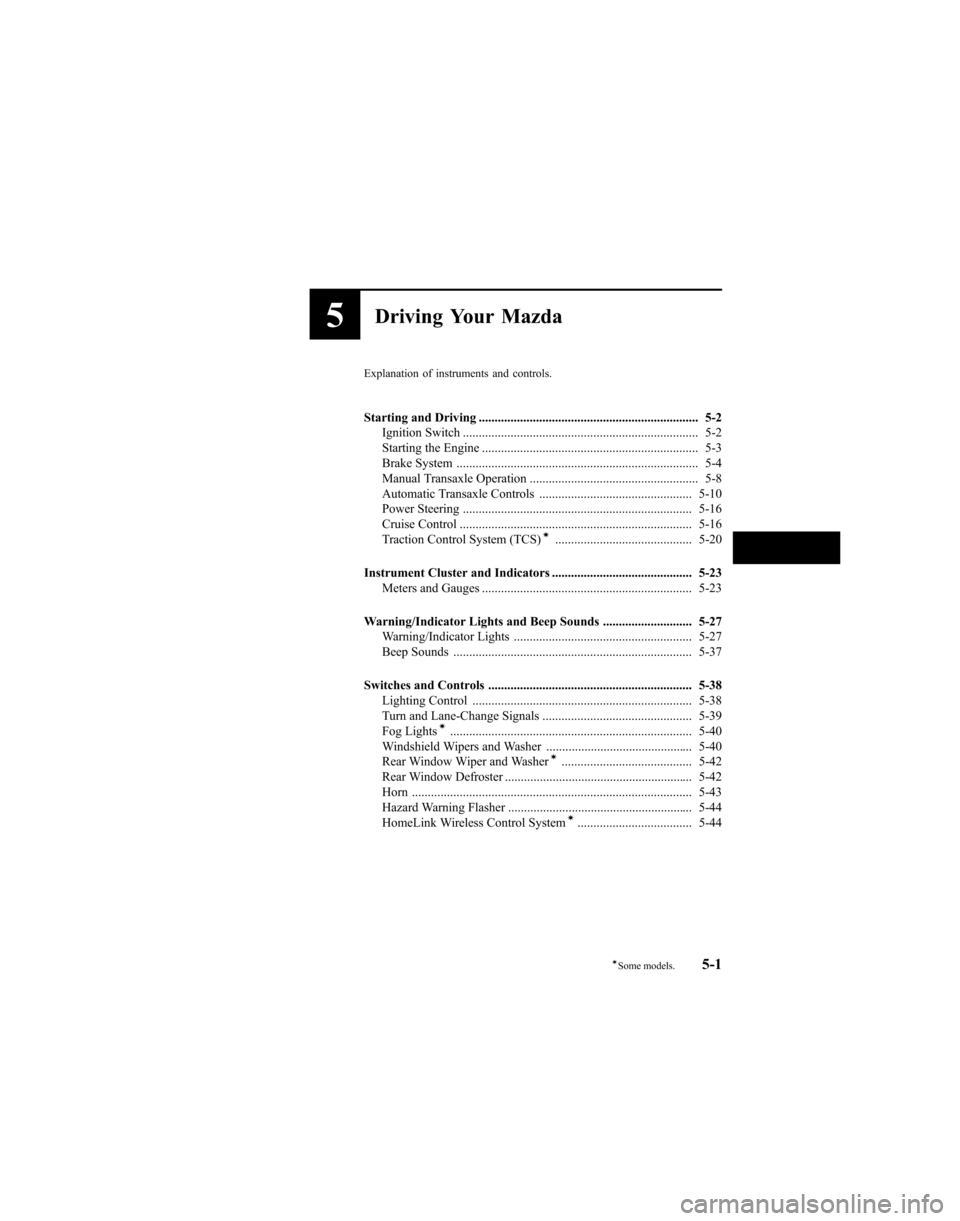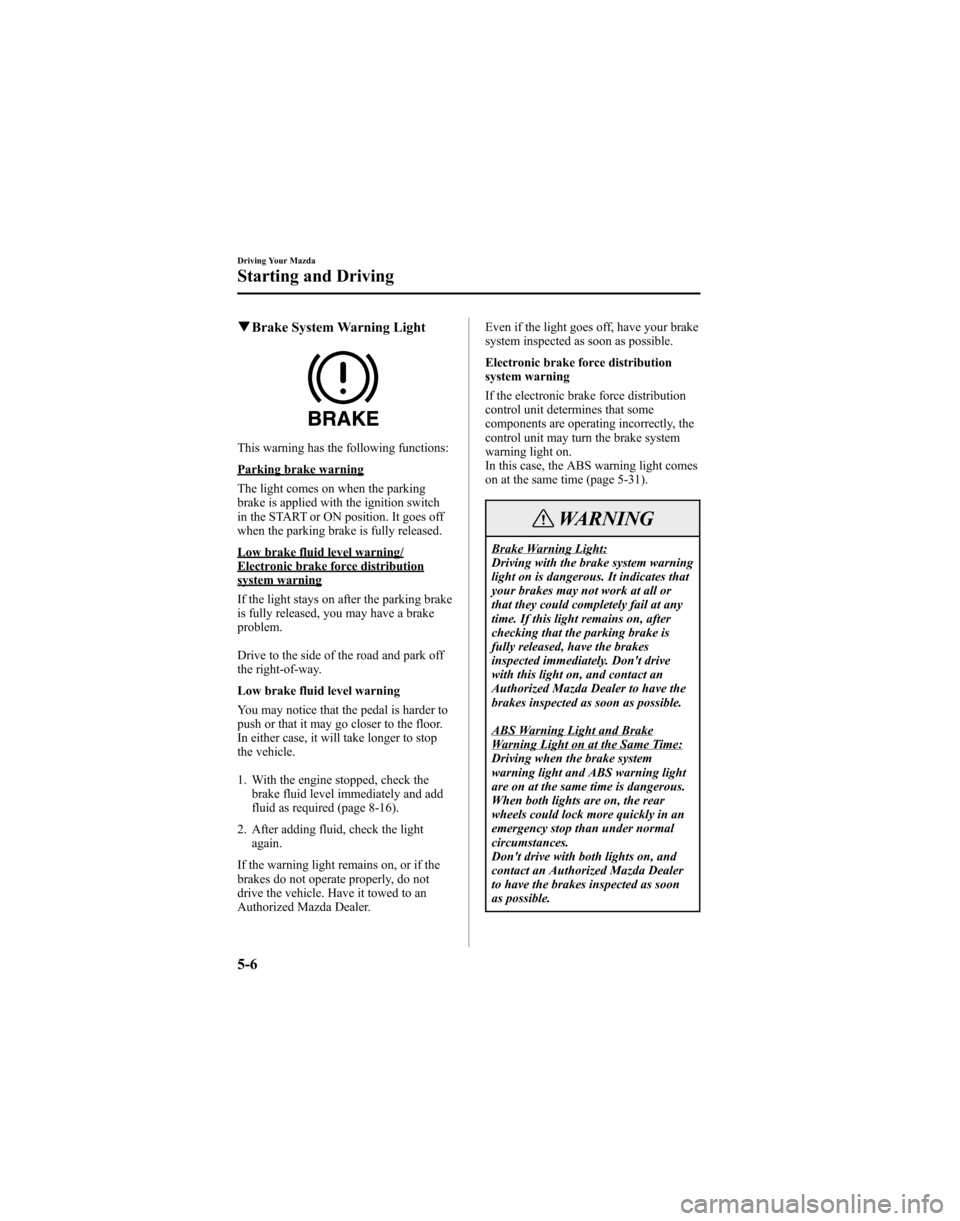warning lights MAZDA MODEL 6 HATCHBACK 2005 Owners Manual (in English)
[x] Cancel search | Manufacturer: MAZDA, Model Year: 2005, Model line: MODEL 6 HATCHBACK, Model: MAZDA MODEL 6 HATCHBACK 2005Pages: 340, PDF Size: 3.08 MB
Page 80 of 340

NOTE
l(U.S.A.)
This device complies with part 15 of
the FCC Rules. Operation is subject
to the following two conditions: (1)
This device may not cause harmful
interference, and (2) this device must
accept any interference received,
including interference that may cause
undesired operation.
l(CANADA)
This device complies with RSS-210
of Industry CANADA. Operation is
subject to the following two
conditions: (1) this device may not
cause interference, and (2) this
device must accept any interference,
including interference that may cause
undesired operation of the device.
NOTE
If the lock and unlock buttons are
pressed sequentially, the hazard
warning lights may not flash correctly.
Lock button
To lock the doors and the hatch/liftgate,
press the lock button and the hazard
warning lights will flash once.
To confirm that all the doors and the
hatch/liftgate have been locked, press the
lock button again within 5 seconds. If
they are closed and locked, the horn will
sound and the hazard warning lights will
flash once.
NOTE
lAll doors and the hatch/liftgate
cannot be locked when any door is
open and the key is in the ignition
switch.
lConfirm that all the doors and the
hatch/liftgate are locked visually or
audibly by use of the double click.
Unlock button
To unlock the driver's door, press the
unlock button and the hazard warning
lights will flash twice.
To unlock all the doors and the hatch/
liftgate, press the unlock button again
within 5 seconds and the hazard warning
lights will flash twice.
NOTE
After unlocking with the transmitter, all
doors and the hatch/liftgate will
automatically lock if one of the doors or
the hatch/liftgate is not opened within
about 30 seconds.
Trunk button
To open the trunk, press the trunk button.
NOTE
The trunk button is disabled when the
glove box-mounted trunk lid release
lock-out button is in the OFF position.
Refer to Remote Trunk Lid Release
Lock-Out on page 3-20.
3-4
Knowing Your Mazda
Doors and Locks
Page 81 of 340

Panic button
You can use the panic button to turn on
the alarm, which allows you to signal for
attention in an emergency.
NOTE
The alarm will work whether any door
is open or closed.
Turning on the alarm
Pressing the panic button once will trigger
the alarm for about 2 minutes and 30
seconds, and the following will occur:
lThe horn sounds intermittently.
lThe hazard warning lights flash.
Turning off the alarm
Press any button on the transmitter.
q Transmitter Maintenance
CAUTION
lMake sure the battery is installed
with the correct pole facing upward.
Battery leakage could occur if it is
not installed correctly.
lWhen replacing the battery, be
careful not to bend the electrical
terminals or get oil on them. Also be
careful not to get dirt in the
transmitter as it could be damaged.
lThere is the danger of explosion if
the battery is not correctly replaced.
lReplace only with the same type
battery (CR2025 or equivalent).
lDispose of used batteries according
to the following instructions.
lInsulate the plus and minus
terminals of the battery using
cellophane or equivalent tape.
lNever disassemble.lNever throw the battery into fire
and/or water.
lNever deform or crush.
Knowing Your Mazda
Doors and Locks
3-5
Page 108 of 340

Theft-Deterrent Systemí
The optional theft-deterrent system is
designed to prevent your vehicle or its
contents from being stolen when all the
doors, hood, and trunk lid/liftgate/hatch
are locked.
If forcible entry is attempted, the system
sounds the horn and flashes the hazard
warning lights.
NOTE
lThe theft-deterrent system operates
with the key or the keyless entry
system transmitter.
lThe system will not function unless
it is properly armed. To properly
secure the vehicle, always make sure
all the windows are completely
closed and all doors and the trunk
lid/liftgate/hatch are locked before
leaving the vehicle. Remember to
take your key and transmitter.
qOperation
System triggering conditions
The horn sounds intermittently and the
hazard warning lights flash for about 3
minutes when the system is triggered by
any one of the following:
lForcing open a door, the hood or the
trunk lid/liftgate/hatch.
lOpening a door, the hood or the trunk
lid by operating an inside door-lock
knob, the hood release handle or the
trunk lid release button. If the system is triggered again, the lights
and horn will activate until a door is
unlocked or the trunk lid is opened with
the key or with the transmitter.
q
How to Arm the System
1. Remove the key from the ignition
switch.
2. Close the hood. Then close and lock all doors and the trunk lid/liftgate/hatch
from the outside using the key or press
the lock button on your keyless entry
system transmitter. The hazard warning
lights will flash once to indicate that
the system is armed.
The following method will also arm the
theft-deterrent system:
Close the hood and the trunk lid/
liftgate/hatch . Press the area on the
door-lock switch marked “LOCK ”
once. Close all doors.
NOTE
Locking the doors with the inside door-
lock knob will not arm the system.
q To Turn off an Armed System
An armed system can be turned off by any
one of the following methods:
lUnlock a door with the key.
lPress the unlock button on the keyless
entry system transmitter.
lInsert the key into the ignition switch
and turn it to the ON position.
The hazard warning lights will flash twice
to indicate that the system is turned off.
3-32
Knowing Your Mazda
íSome models.
Security System
Page 111 of 340

After adjusting the mirror, lock the control
by placing the selector switch in the
middle position.
Mirror defrosterí
To turn on the mirror defrosters, turn the
ignition switch to the ON position and
push the rear window defroster switch
(page 5-42).
qRearview Mirror
WARNING
Blocked View:
Cargo stacked higher than the
seatbacks is dangerous. It can block
your view in the rearview mirror,
which might cause you to hit another
car when changing lanes. Don't stack
things higher than the seatbacks.
Rearview mirror adjustment
Before driving, adjust the rearview mirror
to center on the scene through the rear
window.
NOTE
For the manual day/night mirror,
perform the adjustment with the day/
night lever in the day position.
Reducing glare from headlights
Manual day/night mirror
Push the day/night lever forward for day
driving. Pull it back to reduce glare of
headlights from cars at the rear.
Night
Day Day/Night lever
Auto-dimming mirror
The auto-dimming mirror automatically
reduces glare of headlights from cars at
the rear when the ignition switch is in the
ON position.
Press the OFF button (
) to cancel the
automatic dimming function. The
indicator light will go off.
To reactivate the automatic dimming
function, press the ON button (
). The
indicator light will illuminate.
Indicator lightOFF button
ON button
Knowing Your Mazda
Steering Wheel and Mirrors
3-35íSome models.
Page 118 of 340

Before Getting In
lBe sure the windows, outside mirrors,
and outside lights are clean.
lInspect inflation pressures and
condition of tires.
lLook under the vehicle for any sign of
a leak.
lIf you plan to back up, make sure
nothing is in your way.
NOTE
Engine oil, engine coolant, brake/clutch
fluid, washer fluid, and other fluid
levels should be inspected. See
Maintenance, Section 8.
After Getting In
lAre all doors closed and locked?
lIs the seat adjusted properly?
lAre the inside and outside mirrors
adjusted?
lIs everyone's seat belt fastened?
lCheck all gauges.
lCheck all warning lights when the
ignition switch is turned to the ON
position.
lRelease the parking brake and make
sure the brake warning light goes off.
Always be thoroughly familiar with your
Mazda.
4-6
Before Driving Your Mazda
Before Starting the Engine
Page 125 of 340

5Driving Your Mazda
Explanation of instruments and controls.
Starting and Driving ..................................................................... 5-2Ignition Switch .......................................................................... 5-2
Starting the Engine .................................................................... 5-3
Brake System ............................................................................ 5-4
Manual Transaxle Operation ..................................................... 5-8
Automatic Transaxle Controls ................................................ 5-10
Power Steering ........................................................................ 5-16
Cruise Control ......................................................................... 5-16
Traction Control System (TCS)
í........................................... 5-20
Instrument Cluster and Indicators ............................................ 5-23 Meters and Gauges .................................................................. 5-23
Warning/Indicator Lights and Beep Sounds ............................ 5-27 Warning/Indicator Lights ........................................................ 5-27
Beep Sounds ........................................................................... 5-37
Switches and Controls ................................................................ 5-38 Lighting Control ..................................................................... 5-38
Turn and Lane-Change Signals ............................................... 5-39
Fog Lights
í............................................................................ 5-40
Windshield Wipers and Washer .............................................. 5-40
Rear Window Wiper and Washer
í......................................... 5-42
Rear Window Defroster ........................................................... 5-42
Horn ........................................................................................ 5-43
Hazard Warning Flasher .......................................................... 5-44
HomeLink Wireless Control System
í.................................... 5-44
5-1íSome models.
Page 127 of 340

NOTE
If turning the key is difficult, jiggle the
steering wheel from side to side.
ACC (Accessory)
The steering wheel unlocks and some
electrical accessories will operate.
ON
This is the normal running position after
the engine is started. The warning lights
(except brakes) should be inspected
before the engine is started (page 5-27).
NOTE
When the ignition switch is turned to
the ON position, the sound of the fuel
pump motor operating near the fuel
tank can be heard. This does not
indicate an abnormality.
START
The engine is started in this position. It
will crank until you release the key; then
it returns to the ON position. The brake
warning light can be checked after the
engine is started (page 5-27).
qIgnition Key Reminder
If the ignition switch is in the LOCK or
ACC position, a beep sound will be heard
when the driver's door is opened.
Starting the Engine
NOTE
Engine-starting is controlled by the
spark ignition system.
This system meets all Canadian
Interference-Causing Equipment
Standard requirements regulating the
impulse electrical field strength of radio
noise.
1. Occupants should fasten their seat belts.
2. Make sure the parking brake is on.
3. Depress the brake pedal.
4. (Manual transaxle)
Depress the clutch pedal all the way
and shift into neutral.
Keep the pedal depressed while
cranking the engine.
(Automatic transaxle)
Put the vehicle in park (P). If you must
restart the engine while the vehicle is
moving, shift into neutral (N).
NOTE
(Manual transaxle)
The starter will not operate if the clutch
pedal is notpushed down all the way.
(Automatic transaxle)
The starter will not operate if the shift
lever is notin P or N.
5. Turn the ignition switch to the START position and hold (up to 10 seconds at
a time) until the engine starts.
Driving Your Mazda
Starting and Driving
5-3
Page 130 of 340

qBrake System Warning Light
This warning has the following functions:
Parking brake warning
The light comes on when the parking
brake is applied with the ignition switch
in the START or ON position. It goes off
when the parking brake is fully released.
Low brake fluid level warning/Electronic brake force distributionsystem warning
If the light stays on after the parking brake
is fully released, you may have a brake
problem.
Drive to the side of the road and park off
the right-of-way.
Low brake fluid level warning
You may notice that the pedal is harder to
push or that it may go closer to the floor.
In either case, it will take longer to stop
the vehicle.
1. With the engine stopped, check the
brake fluid level immediately and add
fluid as required (page 8-16).
2. After adding fluid, check the light again.
If the warning light remains on, or if the
brakes do not operate properly, do not
drive the vehicle. Have it towed to an
Authorized Mazda Dealer. Even if the light goes off, have your brake
system inspected as soon as possible.
Electronic brake force distribution
system warning
If the electronic brake force distribution
control unit determines that some
components are operating incorrectly, the
control unit may turn the brake system
warning light on.
In this case, the ABS warning light comes
on at the same time (page 5-31).
WARNING
Brake Warning Light:
Driving with the brake system warning
light on is dangerous. It indicates that
your brakes may not work at all or
that they could completely fail at any
time. If this light remains on, after
checking that the parking brake is
fully released, have the brakes
inspected immediately. Don't drive
with this light on, and contact an
Authorized Mazda Dealer to have the
brakes inspected as soon as possible.
ABS Warning Light and BrakeWarning Light on at the Same Time:
Driving when the brake system
warning light and ABS warning light
are on at the same time is dangerous.
When both lights are on, the rear
wheels could lock more quickly in an
emergency stop than under normal
circumstances.
Don't drive with both lights on, and
contact an Authorized Mazda Dealer
to have the brakes inspected as soon
as possible.
5-6
Driving Your Mazda
Starting and Driving
Page 131 of 340

qAnti-Lock Brake System (ABS)í
The ABS control unit continuously
monitors the speed of each wheel. If one
is about to lock up, the ABS responds by
automatically releasing and reapplying
that wheel's brake.
The driver will feel a slight vibration in
the brake pedal and may hear a chattering
noise from the brake system. This is
normal when the ABS operates. Don't
pump the brakes, continue to press down
on the brake pedal.
WARNING
ABS:
The ABS cannot compensate for
unsafe and reckless driving, excessive
speed, tailgating (following another
vehicle too closely), and hydroplaning
(reduced tire friction and road contact
because of water on the road surface).
You can still have an accident. So
don't rely on ABS as a substitute for
safe driving.
NOTE
Braking distances may be longer on
loose surfaces (snow or gravel, for
example) which usually have a hard
foundation. A vehicle with a normal
braking system may require less
distance to stop under these conditions
because the tires will build up a wedge
of surface layer when the wheels skid.
q ABS Warning Lightí
The warning light stays on for a few
seconds when the ignition switch is turned
to the ON position.
If the ABS warning light stays on while
you're driving, the ABS control unit has
detected a system malfunction. If this
occurs, your brakes will function normally
as if the vehicle had no ABS.
Should this happen, consult an Authorized
Mazda Dealer as soon as possible.
WARNING
ABS Warning Light and BrakeWarning Light on at the Same Time:
Driving when the brake system
warning light and ABS warning light
are on at the same time is dangerous.
When both lights are on, the rear
wheels could lock more quickly in an
emergency stop than under normal
circumstances.
Don't drive with both lights on, and
contact an Authorized Mazda Dealer
to have the brakes inspected as soon
as possible.
Driving Your Mazda
Starting and Driving
5-7íSome models.
Page 151 of 340

Warning/Indicator Lights
Warning/Indicator lights will appear in any of the highlighted areas
Signal Warning/Indicator Lights Page
Brake System Warning Light 5-29
Charging System Warning Light 5-30
Engine Oil Pressure Warning Light 5-30
Check Engine Light 5-30
ABS Warning Light 5-31
Air Bag/Front Seat Belt Pretensioner System Warning Light 5-31
Low Fuel Warning Light 5-32
Driving Your Mazda
Warning/Indicator Lights and Beep Sounds
5-27